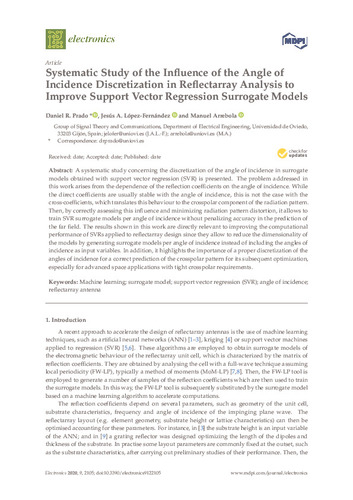Systematic Study of the Influence of the Angle of Incidence Discretization in Reflectarray Analysis to Improve Support Vector Regression Surrogate Models
Subject:
Machine learning
surrogate model
support vector regression (SVR)
angle of incidence
reflectarray antenna
Publication date:
Editorial:
MDPI
Publisher version:
Citación:
Descripción física:
Abstract:
A systematic study concerning the discretization of the angle of incidence in surrogate models obtained with support vector regression (SVR) is presented. The problem addressed in this work arises from the dependence of the reflection coefficients on the angle of incidence. While the direct coefficients are usually stable with the angle of incidence, this is not the case with the cross-coefficients, which translates this behaviour to the crosspolar component of the radiation pattern. Then, by correctly assessing this influence and minimizing radiation pattern distortion, it allows to train SVR surrogate models per angle of incidence without penalizing accuracy in the prediction of the far field. The results shown in this work are directly relevant to improving the computational performance of SVRs applied to reflectarray design since they allow to reduce the dimensionality of the models by generating surrogate models per angle of incidence instead of including the angles of incidence as input variables. In addition, it highlights the importance of a proper discretization of the angles of incidence for a correct prediction of the crosspolar pattern for its subsequent optimization, especially for advanced space applications with tight crosspolar requirements.
A systematic study concerning the discretization of the angle of incidence in surrogate models obtained with support vector regression (SVR) is presented. The problem addressed in this work arises from the dependence of the reflection coefficients on the angle of incidence. While the direct coefficients are usually stable with the angle of incidence, this is not the case with the cross-coefficients, which translates this behaviour to the crosspolar component of the radiation pattern. Then, by correctly assessing this influence and minimizing radiation pattern distortion, it allows to train SVR surrogate models per angle of incidence without penalizing accuracy in the prediction of the far field. The results shown in this work are directly relevant to improving the computational performance of SVRs applied to reflectarray design since they allow to reduce the dimensionality of the models by generating surrogate models per angle of incidence instead of including the angles of incidence as input variables. In addition, it highlights the importance of a proper discretization of the angles of incidence for a correct prediction of the crosspolar pattern for its subsequent optimization, especially for advanced space applications with tight crosspolar requirements.
ISSN:
Patrocinado por:
This work was supported in part by the Ministerio de Ciencia, Innovación y Universidades under projects TEC2017-86619-R (ARTEINE) and IJC2018-035696-I; by the Ministerio de Economía, Industria y Competitividad under project TEC2016-75103-C2-1-R (MYRADA); by the Gobierno del Principado de Asturias/FEDER under Project GRUPIN-IDI/2018/000191.
Collections
Files in this item





